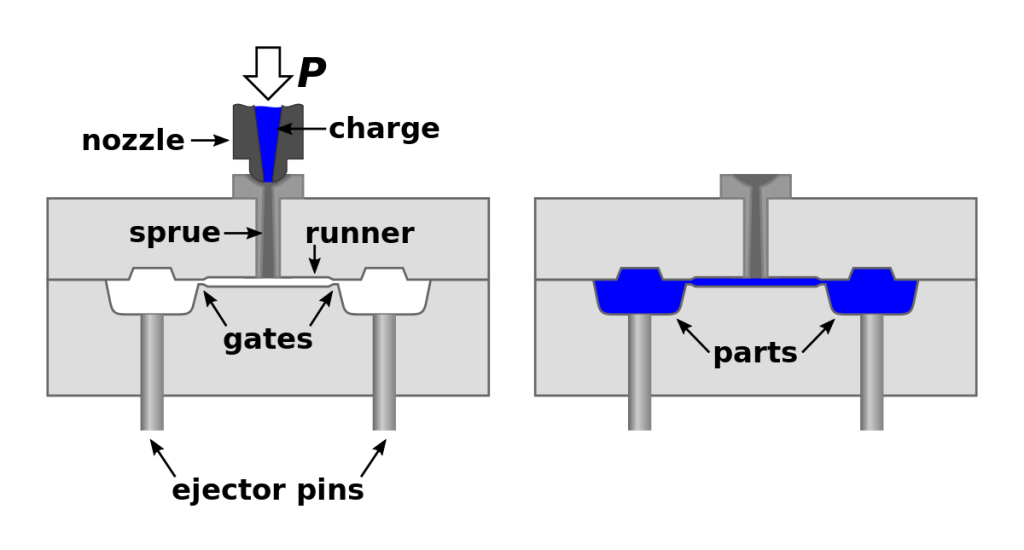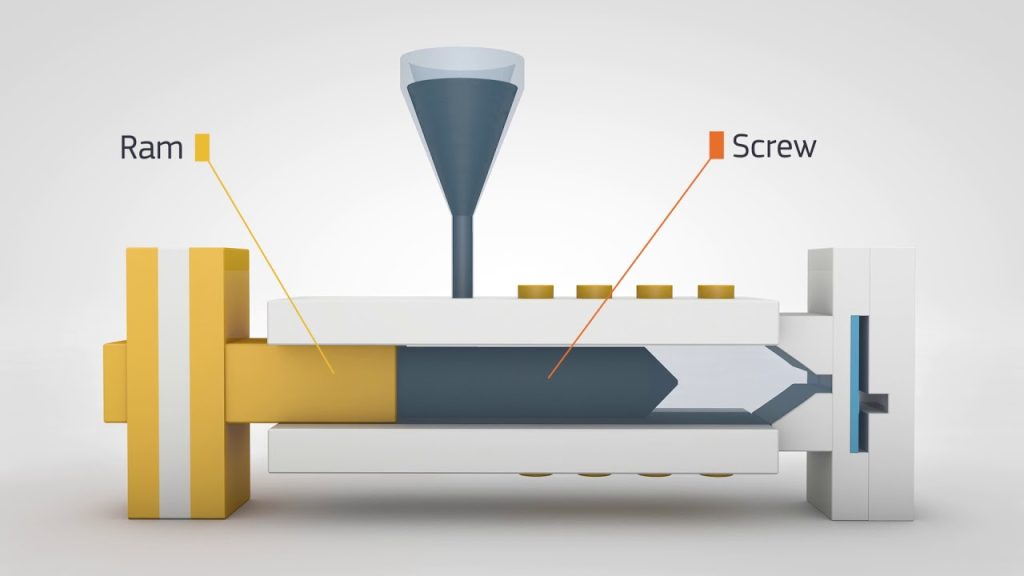Injection molding is a complex process that requires precision and expertise to ensure top-quality products. One crucial aspect of this process is determining the gate size, which is essential in achieving optimal mold filling and avoiding defects.
Choosing the right gate size can be a daunting task, especially for beginners. However, understanding the factors that influence gate size and the techniques used in determining the appropriate size can help you achieve the desired results. In this article, we will explore everything you need to know about gate size in injection molding, from its definition and types to the factors that affect its selection and the methods used in determining the ideal size.
To determine the gate size for injection molding, you need to consider the type of material being used, the size and shape of the product, and the injection molding machine’s specifications. Generally, the gate size should be around 50-70% of the thickest part of the product. However, this can vary depending on the material’s viscosity and the desired flow rate. Consult with an experienced injection molding professional to ensure you choose the correct gate size for your specific project.
How to Determine Gate Size Injection Molding?
Determining the correct gate size in injection molding is a crucial step in ensuring the quality of the final product. The gate is the point of entry for the molten plastic into the mold cavity. In this article, we will discuss the factors that should be considered when determining the gate size in injection molding.
Part Size and Geometry
The size and geometry of the part being molded is a critical factor in determining the gate size. The gate should be large enough to allow the molten plastic to enter the cavity quickly and uniformly. At the same time, the gate should be small enough to prevent excessive flashing or part distortion. A general rule of thumb is to have the gate diameter at approximately 50-70% of the thickness of the part.
Another consideration is the location of the gate. It should be placed at the thickest part of the part or where the flow path is the shortest. This will ensure that the molten plastic fills the cavity uniformly.
Mold Material and Design
The material and design of the mold also play an essential role in determining the gate size. The mold should be designed to minimize pressure drop, which can occur when the molten plastic flows through narrow channels. A larger gate size can help reduce pressure drop, but it can also lead to increased shear stress on the plastic, which can cause degradation.
The mold material should also be considered. A softer mold material may require a larger gate size to prevent deformation, while a harder material may allow for a smaller gate size.
Injection Molding Machine and Process
The injection molding machine and process parameters also impact the gate size. The machine’s injection pressure and speed should be considered when determining the gate size. A larger gate size may be required if the machine’s maximum injection pressure is low.
The process parameters, such as the melt temperature and injection speed, can also affect the gate size. A higher melt temperature and slower injection speed may require a larger gate size to ensure proper filling of the cavity.
Gate Type
The type of gate used also plays a role in determining the gate size. There are several types of gates, including edge gates, submarine gates, and hot runner gates. Each type of gate has different advantages and disadvantages.
Edge gates are the most common and are suitable for simple parts. Submarine gates are used for complex parts with thin walls or where the gate must be hidden. Hot runner gates are used for high-volume production and can reduce waste.
Material Properties
The properties of the plastic material being used also affect the gate size. Viscosity, for example, can impact the flow of the molten plastic through the gate. A higher viscosity material may require a larger gate size to ensure proper filling of the cavity.
The material’s shrinkage rate should also be considered. A higher shrinkage rate may require a larger gate size to compensate for the volume loss during cooling.
Benefits of Proper Gate Sizing
Proper gate sizing can lead to several benefits, including improved part quality, reduced cycle time, and lower production costs. A gate that is too small can cause excessive pressure drop, resulting in part defects or longer cycle times. A gate that is too large can cause part distortion or excessive waste.
Gate Size vs. Mold Size
The gate size should also be considered in relation to the mold size. A larger mold may require a larger gate size to ensure proper filling of the cavity. Similarly, a smaller mold may require a smaller gate size to prevent overpacking or excessive flashing.
Gate Size vs. Production Volume
The production volume should also be considered when determining the gate size. High-volume production may require a larger gate size to reduce cycle time and increase productivity. Low-volume production may allow for a smaller gate size to reduce waste.
Gate Size vs. Part Complexity
The complexity of the part being molded should also be considered when determining the gate size. Simple parts may require a smaller gate size, while complex parts may require a larger gate size to ensure proper filling of the cavity.
Gate Size vs. Cost
Finally, the cost should be considered when determining the gate size. A larger gate size may increase production costs, but it can also lead to improved part quality and reduced cycle time. A smaller gate size may reduce costs, but it may also lead to part defects or longer cycle times.
In conclusion, determining the gate size in injection molding is a complex process that requires consideration of various factors, including part size and geometry, mold material and design, injection molding machine and process, gate type, material properties, mold size, production volume, part complexity, and cost. Proper gate sizing can lead to improved part quality, reduced cycle time, and lower production costs.
Frequently Asked Questions
Injection molding is a complex process that requires proper attention to detail. One of the most crucial decisions you will make is determining the right gate size. Here are some common questions and answers that can help you make the right choice.
What is gate size in injection molding?
Gate size refers to the opening through which the molten plastic is injected into the mold. It is the narrowest point in the mold cavity and determines the flow rate of the plastic material. The gate size should be carefully selected to ensure that the plastic fills the mold efficiently and uniformly.
The gate size is often determined by the thickness of the part, the material being used, and the design of the mold. A smaller gate size may be appropriate for thinner parts or delicate designs, while larger gates are better suited for thicker parts or materials that require higher flow rates.
What are the different types of gates?
There are several types of gates that are commonly used in injection molding, including sprue, edge, pinpoint, sub-gate, and hot runner gates. The choice of gate will depend on the specific needs of your project, such as the size and shape of the part, the material being used, and the desired flow rate and pressure.
Each type of gate has its advantages and disadvantages, and selecting the right one requires careful consideration of all the factors involved. Your injection molding specialist can help you choose the best gate for your project.
What are the factors to consider when selecting gate size?
When selecting the gate size, several factors should be considered to ensure that the plastic fills the mold efficiently and uniformly. Some of the factors to consider include the flow rate of the plastic material, the thickness of the part, the size and shape of the cavity, and the type of gate being used.
You should also consider the pressure required to inject the plastic into the mold, the cooling time required for the plastic to solidify, and the overall quality of the finished part. Your injection molding specialist can help you determine the best gate size for your project based on these factors.
What happens if the gate size is too small?
If the gate size is too small, it can result in incomplete filling of the mold cavity, leading to defects in the finished part. This can also cause excessive pressure buildup, which can damage the mold and result in longer cycle times.
Additionally, a small gate size can lead to excessive cooling time, which can increase the overall cycle time and reduce the productivity of the injection molding process. It is essential to select the right gate size to ensure that the plastic flows smoothly and uniformly into the mold cavity.
What happens if the gate size is too large?
If the gate size is too large, it can lead to excessive flash and other defects in the finished part. It can also cause the plastic to flow too quickly into the mold, leading to uneven filling and poor part quality.
Additionally, a large gate size can require higher injection pressures, which can damage the mold and increase the overall cycle time. It is important to select the right gate size to ensure that the plastic flows smoothly and uniformly into the mold cavity, leading to high-quality finished parts.
In conclusion, determining the appropriate gate size for injection molding is crucial for achieving optimal product quality and minimizing production costs. By considering factors such as the material being used, the geometry of the part, and the desired production volume, manufacturers can make informed decisions about gate size. It is also important to regularly review and adjust gate size parameters as needed to ensure consistent and efficient production.
Overall, the process of determining gate size requires careful consideration and attention to detail. By following best practices and consulting with experienced professionals, manufacturers can achieve successful injection molding outcomes. With the right approach and commitment to quality, businesses can stay competitive in the marketplace and meet the evolving needs of their customers.
Request a quote today!
[contact-form-7 id="1578" title="Contact form"]
Please compress the file into a ZIP or RAR file before uploading. Alternatively, send through your RFQ by email.
enquires@unitymanufacture.com





